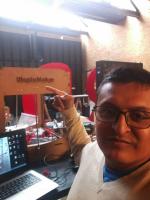Protector facial médico con termoformado - Covid 19
Contents
Presentation
In response to the call against the fight of the covid-19, the manufacture of 3d printed protective masks for medical personnel is proposed. This taking into account that there is a lack of these protection elements and it is essential for medical personnel to have these elements.
Designs
Links:
Resources
Price
| Resource | Quantity | Unit cost (€) | Total cost (€) | link |
|---|---|---|---|---|
| PLA material | 1 | 30 | 30 | - |
| acetate | 1 | 0.5 | 21,99 | - |
- TOTAL: 40€
Explanation
The coronavirus has a size of the order of 12.75 micrometers, this means that masks with pores greater than this diameter would allow the virus to pass through and would not have any protective effect. For this reason, the use of acetate masks is a good complement if used together with a certified face mask, since it serves as a barrier to the entry of the virus. By means of 3D printing, the body of the mask can be manufactured, which will allow to place an acetate as a protective element. These acetates can be obtained in common stationery stores or an radiography can be used as an alternative option; Some makers have applied chemical elements to discolor the radiography, but for the purposes of this project, a conventional acetate will be used.
Protective masks have different advantages:
- They protect the user's eyes, nose and mouth from drops that a person in front of them can expel when coughing, speaking or sneezing.
- Prevents the same user from touching his face.
- It protects the rest of the people close to the user of the mask, from the drops that the user himself can expel from his mouth.
It is for this reason that its use is essential for medical personnel.
how to build it
Download the corresponding files, present in the "designs" section of this project. Then load the file into the printer program and note the following settings:
- Material: PLA
- Extrusion temperature: 210°c
- Bed temperature: 60°c
- Layer thickness: 0.2
- Speed: 60mm/s
- Filling: 20%
Then assemble the body of the mask with the acetate, making sure that the acetate is fixed and without risk of detachment.
Results
The mask should be as shown in the following image:
Tasks
April 2020
| Date | Nom | Description | Temps | TS |
|---|---|---|---|---|
| 01/04 | David F | _ | h | TS |
| 01/04 | David F | _ | h | TS |
| 01/04 | David F | _ | h | TS |
| 01/04 | David F | _ | h | TS |
| 01/04 | David F | Documentation | 1h | 3 TS |
Project manager
| Maker | Image | Profile |
|---|---|---|
| Avila Juan Pablo |
collaborators
| Maker | Image | Profile |
|---|---|---|
| Figueredo David |




